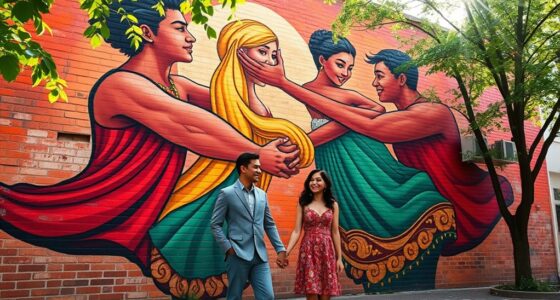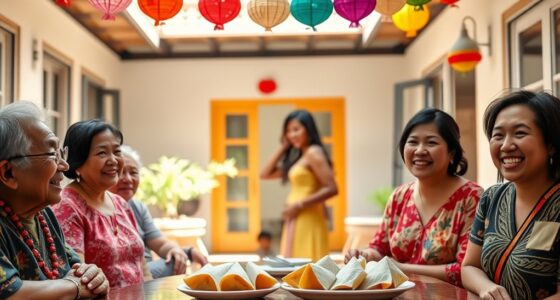Filipino festivals create lasting memories through vibrant traditions and emotional connections you’ve experienced with family and friends. These celebrations blend rich cultural roots with modern expressions, allowing you to feel a deep sense of belonging. As you participate in lively parades and joyous gatherings, you strengthen community bonds and cherish moments that you’ll pass on to future generations. Discover how these dynamic events reflect cultural heritage and foster connections that resonate beyond the festival days.
Key Takeaways
- Festivals weave together family traditions, creating shared experiences that strengthen emotional bonds across generations.
- Engaging in vibrant activities and cultural performances fosters a sense of belonging and community connection.
- Elders pass down stories and cultural significance, enriching younger generations’ understanding of their heritage.
- The lively atmosphere and artistic expressions during festivals create unforgettable memories that resonate for years to come.
- Participation in local celebrations promotes shared joy and kinship, leaving lasting impressions on individuals and families alike.
The Cultural Roots of Filipino Festivals
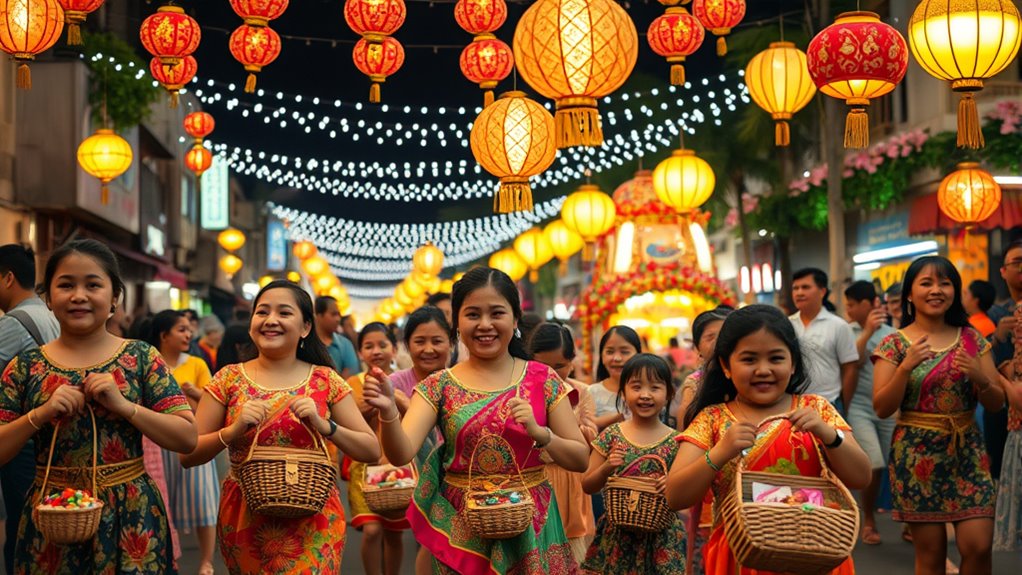
Filipino festivals have deep cultural roots that intertwine various historical influences, shaping the vibrant celebrations we see today. You’ll find that these festivals trace back to pre-colonial times, reflecting indigenous customs and traditions.
With the arrival of Spanish colonizers, Catholicism fused with local practices, creating unique celebrations. Early festivals honored deities and marked agricultural milestones, promoting community unity.
The fusion of Catholicism and local traditions during Spanish colonization gave rise to vibrant and unique Filipino celebrations.
Events like Sinulog and Ati-Atihan commemorate significant historical moments, while others pay homage to ancestors, preserving cultural heritage.
You’ll notice lively music, dance, and feasting, all integral to these festivities. The participation of community members, young and old, reinforces social bonds and pride.
Through these rich traditions, you connect with the essence of Filipino culture and its evolution over time.
Emotional Connections Through Celebration

Celebrating together during festivals creates emotional bonds that strengthen community ties and foster a sense of belonging.
When you participate in festival events, you not only enjoy shared experiences but also contribute to collaborative planning and execution. This active involvement enhances your sense of belonging, promoting emotional well-being through supportive networks.
As you engage with family and friends, you experience psychological improvements that boost happiness and mitigate stress. Festivals highlight the importance of kinship, reinforcing social capital that sustains long-lasting connections.
The cultural rituals and practices you partake in preserve heritage while uniting communities around shared values.
Ultimately, these celebrations create lasting memories, enriching your life and deepening your connection to those around you.
Economic Impact and Community Engagement
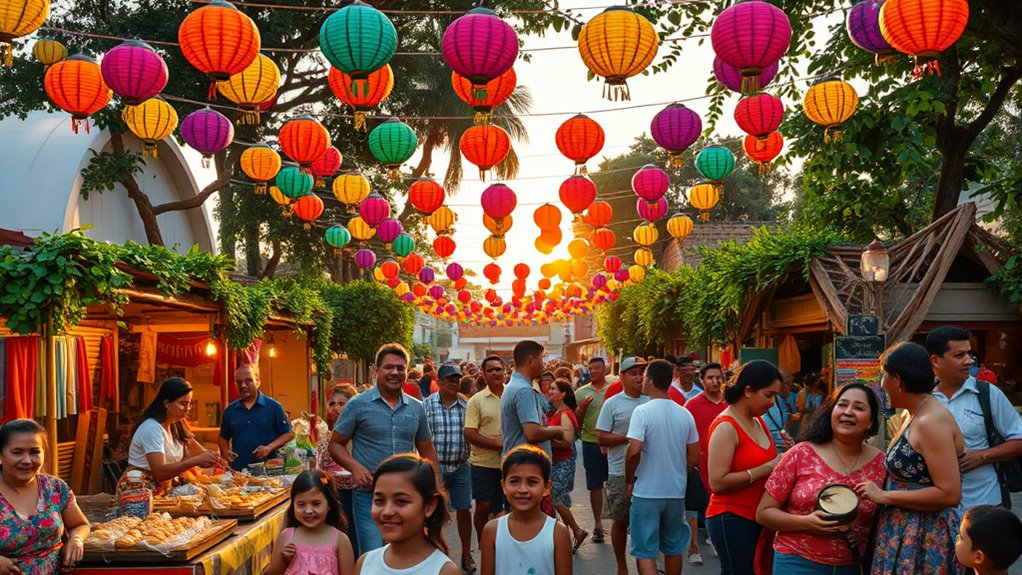
Festivals play an essential role in boosting local economies and fostering community engagement. They attract both local and international visitors, increasing revenue for local businesses.
You’ll notice heightened demand for accommodations, leading to better occupancy rates during festival times. Local vendors thrive, especially those selling food, souvenirs, and crafts, thanks to the surge in tourist traffic.
Additionally, festivals involve locals in preparations and performances, strengthening community bonds and creating a sense of shared achievement. You’ll see cultural exchanges that promote understanding among diverse groups.
These events also provide job opportunities, from hospitality to logistics, benefiting the community. Ultimately, festivals not only celebrate culture but also invigorate the local economy and unite residents.
The Visual Spectacle of Festivals
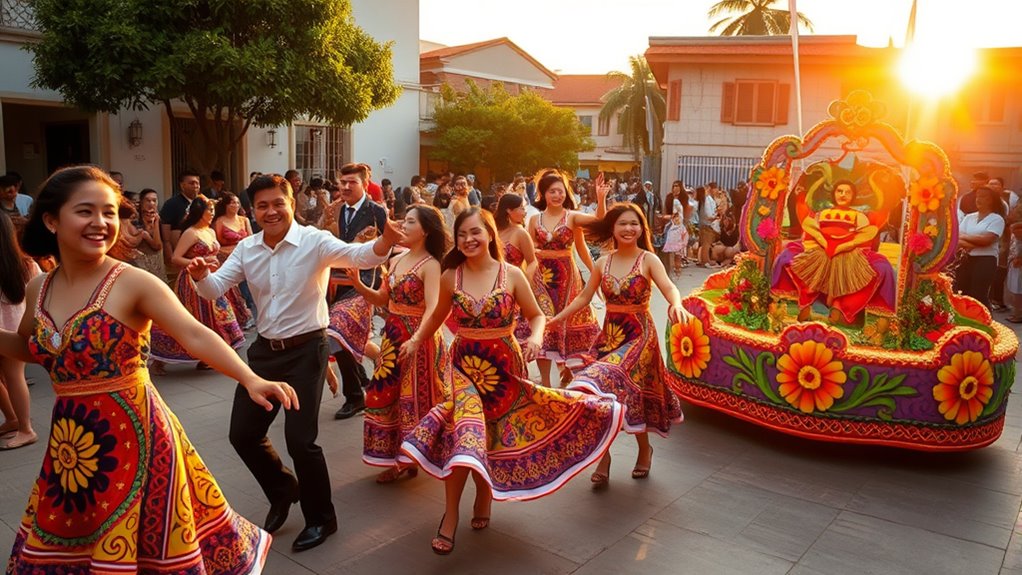
The vibrancy and energy of local festivals create a visual spectacle that captivates both participants and spectators. You’ll be amazed by the vibrant costumes at events like Sinulog and Ati-Atihan, which showcase a deep commitment to cultural heritage. Traditional dances, with their synchronized movements and rhythmic beats, enrich the experience. Embracing sustainable practices during these festivals can enhance their cultural significance and minimize environmental impact. Additionally, these events often feature global flavors that reflect the diverse culinary influences present in Filipino cuisine, offering a feast for both the eyes and the palate.
Marvel at the artistic decorations and elaborate floats that transform streets into a canvas of color and creativity. Iconic symbols, such as the Santo Niño, add to the event’s identity. Nighttime displays, featuring fireworks and lanterns, create a magical atmosphere. With community involvement and modern art integration, each festival becomes a unique celebration of culture, leaving you with unforgettable memories and a deeper appreciation for Filipino traditions. Additionally, just as Brazilian festivals feature cultural influences that highlight their diverse culinary practices, Filipino festivals similarly reflect a rich tapestry of traditions.
Intergenerational Memories and Legacy
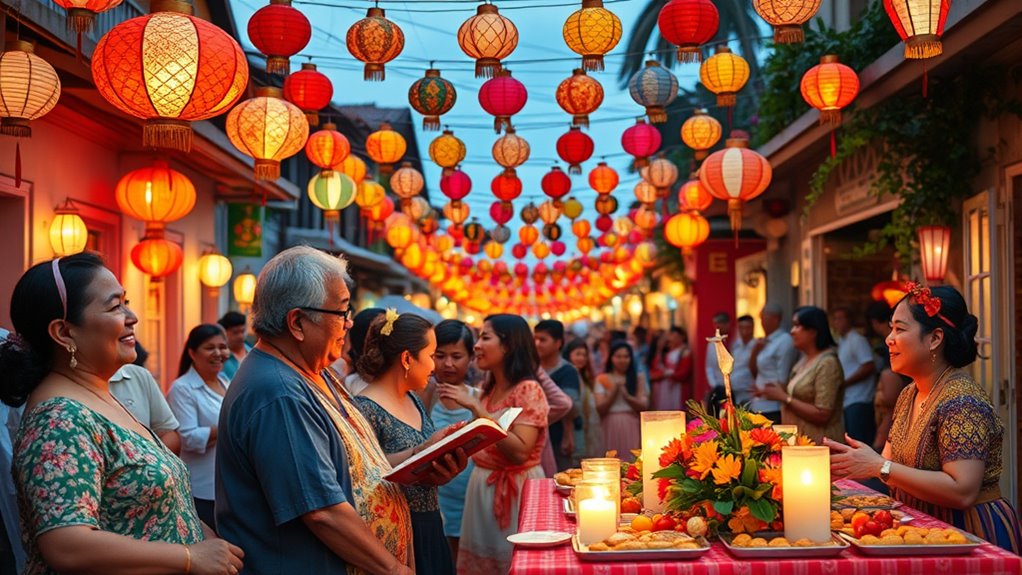
While many may think of festivals as mere celebrations, they actually serve as essential links between generations, weaving a rich tapestry of memories and traditions.
You’ll find families of all ages participating together, strengthening those intergenerational bonds. Elders share stories about the festivals’ significance, passing down their rich history and cultural identity.
As younger generations learn traditional dances and crafts, they help preserve these practices. The emotional connections formed during these events create cherished memories that resonate for years.
When you taste traditional dishes or witness folkloric performances, you’re not just enjoying a festival; you’re embracing a legacy.
In this way, Filipino festivals promote community spirit and pride, ensuring that cultural heritage remains alive for future generations.
Social Media and Modern Festival Experiences
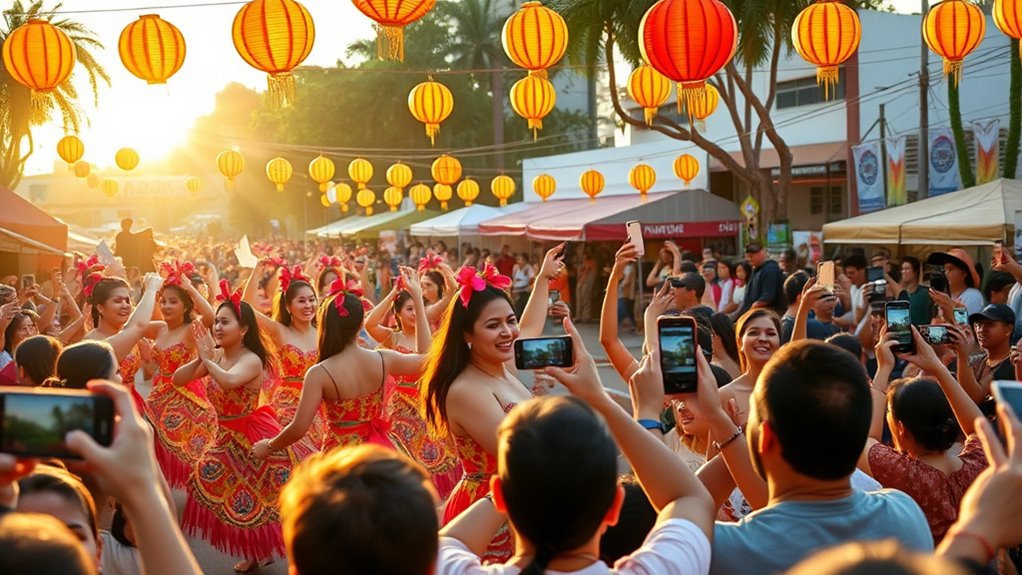
As families gather to celebrate Filipino festivals, the role of social media becomes increasingly significant in shaping modern festival experiences.
You’ll notice platforms buzzing with vibrant images and videos, allowing you to share and discover unique moments in real-time. Influencers enhance your experience by promoting the festivity through engaging content. User-generated posts amplify the festival’s popularity, while interactive quizzes and contests keep you entertained and connected.
Social media brings festivals to life, showcasing vibrant moments and fostering community engagement through influencers and user-generated content.
As you scroll, you can revisit cherished memories, which fuels your desire to attend again. Social media also showcases cultural diversity, giving voices to communities and preserving traditions.
Ultimately, these digital interactions enhance your overall satisfaction and foster a sense of belonging in the festival community.
Frequently Asked Questions
What Is the Origin of Specific Filipino Festival Traditions?
You’ll find that specific Filipino festival traditions originate from a blend of indigenous practices and Spanish influence.
These celebrations began in pre-colonial times, honoring deities and marking agricultural events. With colonization, Catholicism merged with local customs, creating unique traditions.
For instance, the Ati-Atihan Festival commemorates Malay datus, while the Sinulog Festival highlights the arrival of Christianity.
Each festival reflects a rich cultural heritage, showcasing the creativity and resilience of the Filipino people.
How Do Festivals Vary Across Different Regions in the Philippines?
In the grand tapestry of the Philippines, each thread tells a different tale. You’ll discover that festivals vary like colors on a painter’s palette.
In Cebu, you’ll dance with the rhythms of Sinulog, while in Aklan, the Ati-Atihan echoes the voices of the past.
Pahiyas in Quezon showcases nature’s bounty, and in Baguio, Panagbenga blossoms with flowers.
Each region’s celebration highlights its unique identity, weaving together a vibrant cultural mosaic you can’t help but cherish.
What Preparations Go Into Organizing a Filipino Festival?
When you organize a Filipino festival, you start by defining a theme that reflects cultural traditions.
You’ll allocate a budget for venue rental, talent fees, and marketing. Selecting a venue that accommodates large crowds is crucial. Engaging the local community in planning fosters involvement.
You’ll also book performers, arrange workshops, and plan food festivals. Logistics like venue setup, security, and waste management are essential for a smooth event, ensuring everyone enjoys the celebration.
Are There Any Unique Customs Associated With Festival Food?
When food dances in vibrant harmony, you’ll find unique customs at Filipino festivals. You’ll see families preparing special dishes to honor their heritage, like lechon and kakanin.
During Noche Buena, you’ll gather with loved ones, sharing symbolic foods that represent prosperity. You might even witness cooking competitions, where local chefs showcase their skills.
These traditions not only celebrate flavors but also weave a rich tapestry of community and culture that brings everyone together.
How Do Festivals Influence Local Art and Music Scenes?
Festivals influence local art and music scenes by providing vibrant platforms for creativity.
You’ll see artists showcasing their work, blending traditional and modern styles, which sparks innovative collaborations. Local musicians get the chance to perform, enriching the music landscape with diverse genres.
Conclusion
As you immerse yourself in the vibrant world of Filipino festivals, you can’t help but feel the deep emotional connections they foster. Did you know that over 20 million tourists flock to these celebrations each year? This not only boosts local economies but also strengthens community bonds. Whether it’s the colorful parades or the joyous laughter shared among generations, these festivals create lasting memories that you’ll cherish forever. So, get ready to experience the magic firsthand!



